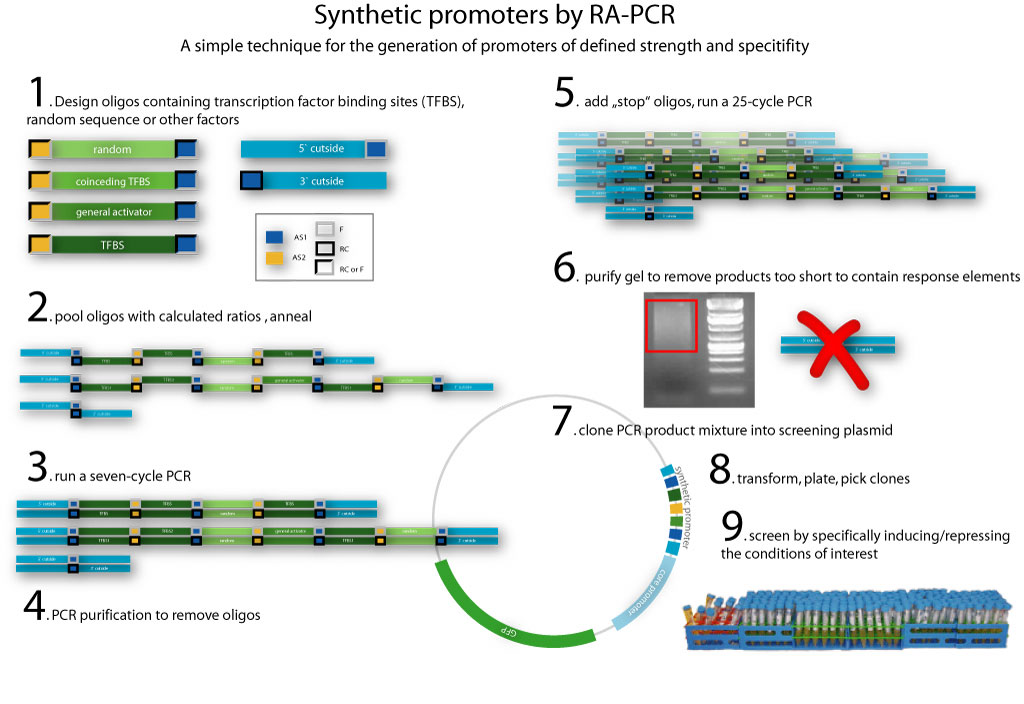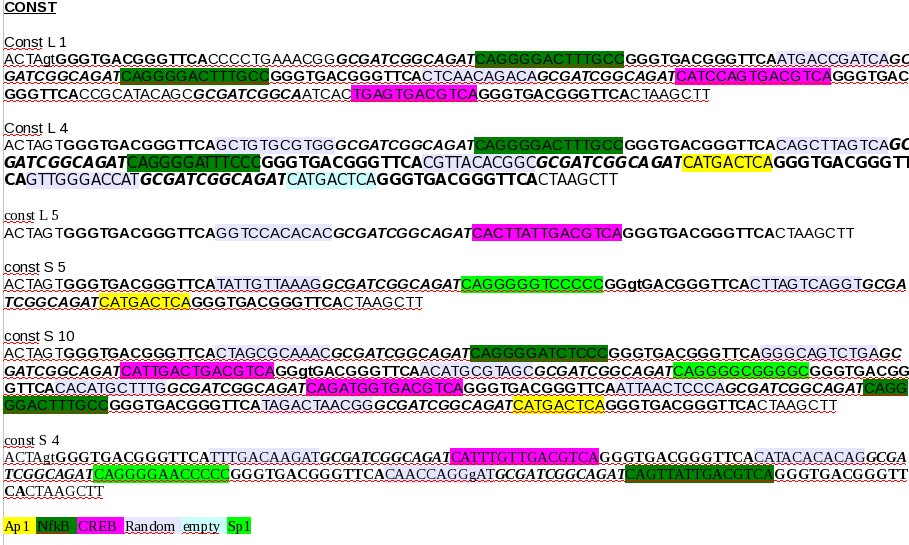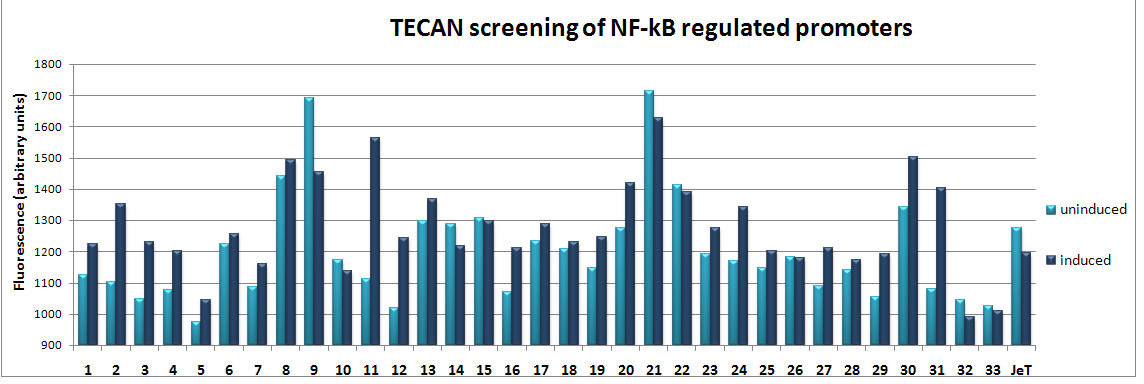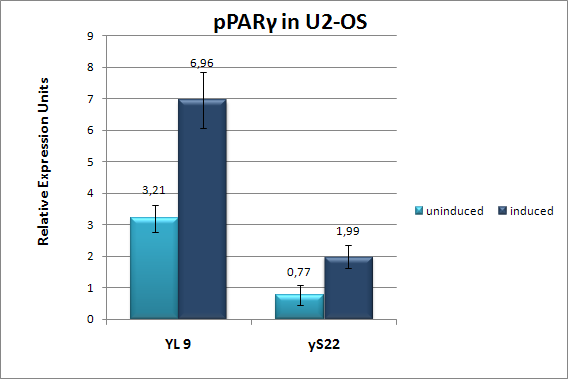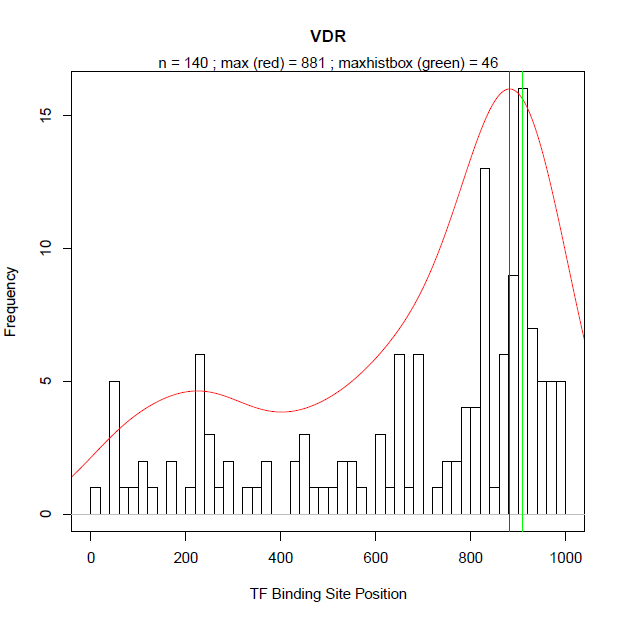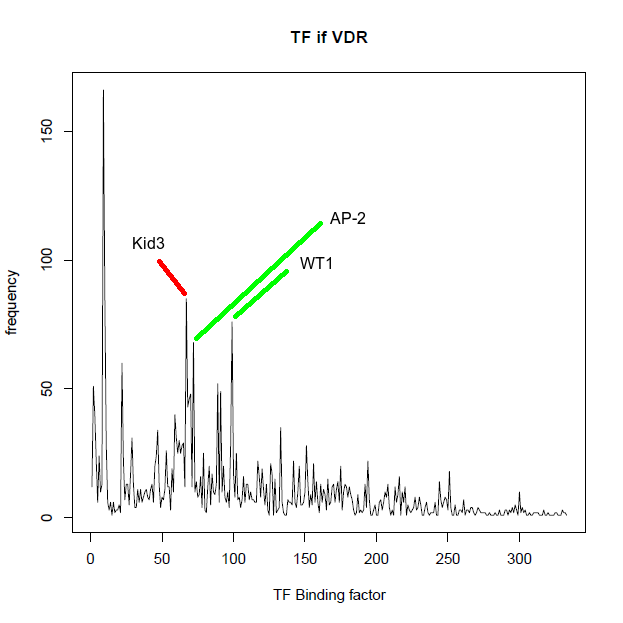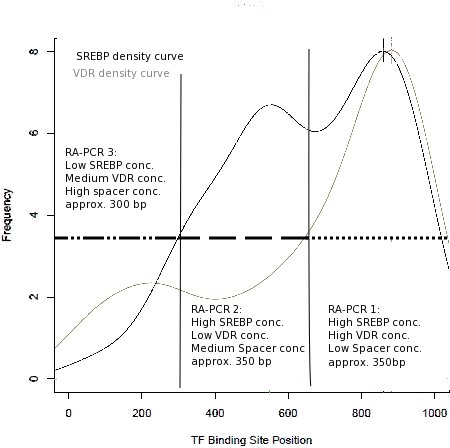Team:Heidelberg/Project Measurement
From 2009.igem.org
|
Synthetic PromotersThe central question of the synthetic promoter project is: Are we able to make specific promoters by predicting their sequence in silico? Or, going even further: Are we able to develop a standard method for creating promoters of
How this is supposed to work... Read on! AbstractPromoters are the key regulators of gene expression. Possessing promoters which are active under a desired condition, at a desired strength and in a specified tissue is of great value for Plant Biotechnology, Gene Therapy and fundamental research in Bioscience. Therefore, it has become a desire to synthetically construct promoters responsive to a variety of pathways. We explore two ways to the synthesis of promoters: On one hand, we have developed a bioinformatical model and database (HEARTBEAT) describing the structure of promoters responsive to user-defined inputs. On the other hand, we have developed a biochemical method for the synthesis of randomized promoter libraries. Using this method, we have created a library of constitutive promoters of varying strength. Also, we have created libraries of promoters putatively responsive to a variety of pathways. We have screened these libraries for functional, pathway responsive promoters and present a detailed characterization of a NF-κB responsive promoter of our making. We finally discuss ways to combine randomized biochemical synthesis and bioinformatical modeling to propose a method towards the generation of promoters of complex regulation (i.e. by multiple pathways). IntroductionPromoters are the key regulators of gene expression. Possessing promoters which are active under a desired condition, at a desired strength and in a specified tissue is of great value for Plant Biotechnology, Gene Therapy and fundamental research in Bioscience. Most efforts of obtaining such promoters focus on cloning them from Nature. This approach is, in eukaryotes, flawed for three reasons: First, promoters in eukaryotic cells are very complexly regulated by a wide variety of transcription factors, and thus, pathways [1]. Therefore, natural promoters cannot be used reliably as transcriptional assays. Second, a promoter might be required to be active under a set of conditions for which no natural promoter exists. Third, for precise control of gene expression levels, promoters of human-defined transfer functions and expression strengths are required. Therefore, efforts have emerged to synthetically construct promoters. Two concepts of synthetic promoters in mammalian cells co-exist independently from each other. One is the concept of "genetic switches" (see [10] for a recent review) - promoters which can specifically be induced by a stimulus mammalian cells are usually insensitive to, e.g. tetracycline [11]). Much fewer efforts have been put into developing promoters sensitive to endogenous signals (referred to as "synthetic promoters" in the rest of this article). Such promoters are of very high value for a broad variety of applications. Three examples should demonstrate this. First, in virotherapy for cancer and other diseases, it has become a desire to express toxic genes only in affected cells (reviewd in [12]). For example, breast cancer cells are characterized by high levels of estrogen receptor. Constructing a promoter which is active only at high estrogen receptor levels (plus, maybe, only in cells which are irradiated, as ER can be very active in other tissues of the female reproductive tract also) might therefore help developing novel breast cancer therapies. Second, biologists studying pathway interactions are in need for transcriptional assays, that is promoters which are specifically activated by a single transcription factor. Third, the concept can be transferred to plants, where synthetic promoters can be very valuable, as plant biotechnology is always in need for novel tissue- or development-specific promoters. Three approaches exist to construct synthetic promoters responsive to endogenous factors. First, the by structure of promoters is modeled by generating large data sets describing the relative spacing and coincidence of transcription factors (reviewed in [4]). To our knowledge, such predictions have not been tested in vivo. Second, promoters are generated by randomly or repeatedly cloning response elements upstream of a core promoter. To our knowledge, repeated cloning of response elements works well [5] and is frequently applied, but no suggestions exist on how to apply this strategy to the generation of more complexly regulated promoters. The random creation of promoters works well to generate constitutive promoters [6] and was even applied to broadly identify activating elements [2], but no promoters of specific regulation have been described for this approach. A third approach is the randomization of spacer elements between transcription factor binding sites, which is applied to generate libraries of promoters of varying strength [3], [8]. In order to be able to design synthetic promoters, an understanding of natural promoters is required. Mammalian promoters can be subdivided into several "domains". The core promoter is the binding site of the basal transcription machinery, i.e. RNA polymerase and associated factors. Core promoters differ in composition, but are more or less similar for most genes (reviewed in [9]). The main regulatory domain is the proximal promoter, which is where regulatory elements bind. It can be very large (4kb), meaning that some transcription factors regulate transcription despite being very far away from the RNA polymerase. This is mainly possible because of the three-dimensional structure the DNA adopts. In addition to this, there are even more distal elements that are referred to as "enhancers" and "silencers". A further challenge is that some transcription factors are not able to initiate transcription on their own, but rather they require other transcription factors for their activity. ResultsRA-PCR, a method for the generation of randomized promoter librariesWe have developed a standard method (termed "Random Assembly PCR / RA-PCR") for the construction of randomized promoter libraries. We modified Assembly PCR [7] to create randomized promoters instead of ordered genes by using different oligos containing a transcription factor binding site (or random DNA) plus two annealing sequences (see Figure 1 for a comprehensive explanation of the method). We use two sets of oligos, one for the top strand, one for the bottom strand. The oligos for each strand have the same annealing sequences (which are complementary to the annealing sequences of the other strand). If these oligos are pooled, they will randomly anneal to each other, thus generating randomized repeats of the transcription factor binding sites of interest at varying spacing. In order to be able to clone the construct, we also add two stop oligos (termed stop 5' and top 3') which contain only one annealing sequence, plus a cutsite (SpeI 5', HindIII 3'). Double-stranded DNA is created by running a seven-cycle PCR, and amplified by a 25-cycle PCR. Then, the resulting (proximal) promoter is cloned 5' of a core promoter (we used the core promoter of JeT [8]) by inserting it into pSMB_MEASURE, the promoter measurement plasmid we developed (from there, it can be excised like any standard biological part in a submission plasmid). Thus, a mixture of different promoters in the same plasmid backbone is generated. These can then be transformed into bacteria. Each colony represents a single putative promoter, which can the be transfected into mammalian cell under the conditions of interest, plus control conditions. Promoters active under the desired conditions, but not under control conditions, are selected for further characterization. Please see a detailled protocol for RA-PCR below. Generation of a library of constitutive promoters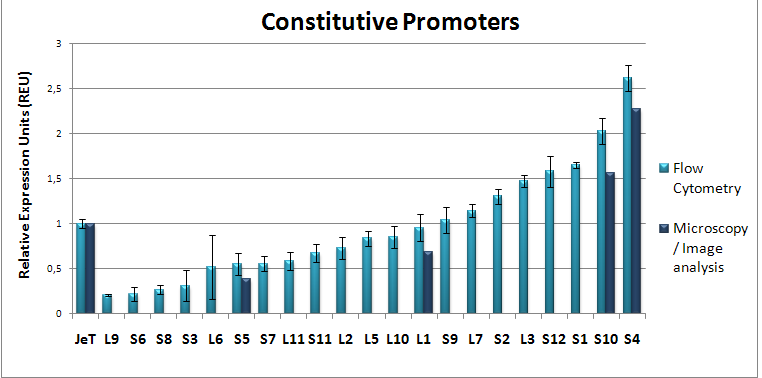 Figure 2: A library of constitutive promoters created by RA-PCR Promoters were analyzed by the standards developed in the Measurement part of our project in HeLa cells. As a first application of RA-PCR, we have created a library of constitutive promoters. We performed RA-PCR on oligos containing binding sites for some well known generally activating transcription factors (Sp1, Ap1, CREB, NF-Y) which we identified from literature search [2],[6],[8]. We also added NF-κB responsive oligos as NF-κB has non-specific activity and is therefore used by a variety of viral constitutive promoters, e.g. the HIV promoter [13]. We picked 24 colonies, two of which we dismissed after a test digest (not shown). Figure 3 shows the sequence analysis of some randomly selected clones and demonstrates that RA-PCR is able to generate randomized repeats of Oligos. We then measured the activity of the clones we picked by applying the Concept of Relative Expression Units (REU) we developed. Figure 2 shows that we have been able to create a library of promoters of varying strength, some of which have an expression strength higher than JeT (which was not accomplished by JeT's developers, although attempted [8]). Such a library is of great value for fine-tuning gene expression levels. Generation and screening of a library of promoters putatively responsive to NF-κB
RA-PCR was conducted with Oligos containing a NF-κB binding site, plus a small number of "general activators" (NF-Y, Sp1, Ap1, CREB) . Box 1 demonstrates how the oligos were designed from a frequency matrix. 33 clones were picked, miniprepped and transfected. NF-κB was then induced by the addition of TNF-&alpha (2.5µM) for 10 hours, and left uninduced as a control. The plate was then scanned by TECAN, an automated fluorescence plate reader. TECAN is very imprecise on eukaryotic cells, and the arbitrary fluorescence we meausred is not proportional to REU or another precise measure of mammalian promoter activity, but it can serve as a rough indicator of promoter induction. The result (Fig.4) shows that most clones appear not to be induced by NF-κB, whereas others are induced at varying levels of strength. Considering the sequence analysis of some randomly selected clones (Fig.5), this result is not intuitive, as most sequences contain a NF-κB binding site, but it demonstrates that simply cloning repeats of a Transcription Factor Binding Site in front of a core promoter will not necessarily work. We picked clone 31 for further characterization in REU. 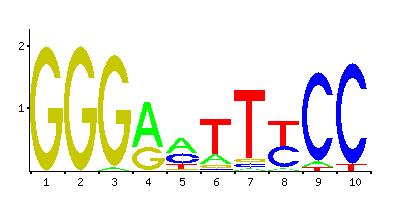 Box 1: RA-PCR allows for synthesis of promoters responsive of imprecisely described transcription factors. Considering the graphical representation of NF-kappaB's frequency matrix shown above (source: JASPAR), the oligo can be designed in order to represent this matrix, instead of a static NF-kappa B binding site. A sensible representation of this matrix would be GGGRHTTYCC (for the IUPAC nucleotide code, refer to bioinformatics.org). Most oligonucleotide manufactures provide the option to synthesize such mixtures of individual oliogs without further cost. As our method is PCR-based (unlike other methods such as [5] and [6]), we are able to synthesize even promoters responsive to badly-described transcription factors Characterization of a NF-κB responsive promoterHannah and Corinna, I need you data. Possibly also ibidi cotransfection, video etc. RA-PCR can generate promoters responsive to a variety of pathwaysWe performed RA-PCR to construct promoters putatively responsive to Transcription factors as diverse as p53 (DNA damage sensor), pPARγ (metabolism & diabtetis), SREBP (Sterol nutrition), HIF (hypoxia) and Estrogen receptor . While screening these promoters we found the following:
HEARTBEAT, a model describing promoter structureBased on the assumption that transcription factors (TFs) have a spatial preference for binding to the natural promoters' sequence concerning the distance to the transcriptional start site (TSS) [14], we developed HEARTBEAT (Heidelberg Artificial Transcription Factor Binding Site Engineering and Assembly Tool). In a first step 4395 human promoter sequences 1000 bp upstream from the TSS obtained from the UCSC genome browser were analysed by the program “Promotersweep” [15]. Promotersweep is able to assign transcription factor binding sites (TFBS) to a given sequence by retrieving and combining information from three homology databases (EnsEMBL Compara, NCBI HomoloGene, DoOP database), five promoter databases (EPD, DBTSS), six sequence motive identification tools (e.g. Meme, Gibbs Motif Sampler) and two matrix profile databases (Jaspar Core Library, Transfac Professional Library). Each TFBS motive is further classified into weak, conserved and reliable according to the quality of the assignment. The final result of Promotersweep can be divided into general spatial information about the TFBS and the consensus sequence on the one hand and further detailed facts about the associated gene on the other. In figure 7 the spatial distribution of VDR (Vitamin D receptor) binding sites within 140 natural promoter sequences is shown as an example. The size of each bin equals the number of VDR-TFBS within a range of 20 bps. The solid line represents the probability density function (pdf). Here, the maximum of the pdf is located 54 bps upstream to the TSS indicated by the vertical line. Natural promoter sequences usually exhibit multiple TFBS which implies dependencies between different TFs according to their binding behaviour to the DNA. Figure 8 shows the frequency distribution of coincidental appearing TFBSs if VDR is present. The highest peak represents VDR itself. The next three highest peaks are Kid3 (inhibitory), WT1 and AP-2 (stimulatory). In total, together with VDR, there are over 300 different TFBS coincidentally present. Both plots represent data deduced from the Heartbeat-database which enable a well-defined synthesis of promoter sequences.
An in vivo test of predicted promoter sequencesongoing work DiscussionThe results shown above demonstrate the potential of RA-PCR towards the synthesis of any promoter. Even by analyzing modest amounts of clones for each individual pathway, we were able to obtain promoters of a wide variety of strength and inducibility. Also, we were able to obtain constitutive promoters of greater strength than JeT, which has not been possible before[8]. Many insights about promoter regulation are possible by analyzing different promoters created by RA-PCR. For example, clone 3 and clone 11 (see figure 4 and 5) differ only in the positioning of the single response element (RE), but still, induction strength differs threefold. This gives hints about Nf-κB's binding preference. A systematic study of promoters generated by RA-PCR and their strength could therefore be used to develop a comprehensive model of transcriptional regulation. Nao, kann man hier dein model verlinken und mit einem oder zwei stzen elegant beschrieben? Improving RA-PCRScreening conditions and induction strength: As noted above, we experienced difficulties inducing some of the pathways (namely, HIF and p53). From our cell culture work, we learned that finding the ideal timepoint of induction for a certain pathway and the ideal conditions is very difficult even with literature at hand. Also, one would expect a much higher induction than the one observed for the NF-κB responsive clone we describe. Our induction levels might be low because NF-κB has a high constant actvity link to nfkb review here, especially if the cells encounter rough cell culture conditions. Therefore we suggest that for future screening, a library of siRNAs for the transcription factors of interest should be compiled. Also, a library of transcription factors mutated to be constantly active is is required. With these libraries at hand, individual transcription factors can be knocked down, and activated specifically at 100% efficiency. This will greaty facilitate screening and parts characterization. Generation of down-regulated promoters As shown, we were able to generate a set of promoters upregulated by certain factors. For several applications, promoters of a high constant strength, which become down-regulated by a signal, are required. We think it might be possible to construct such promoters by performing a RA-PCR with oligos containing weak binding sites for generally activating transcription factors (that is, binding sites which deviate from the consensus sequence), and to add some oligos containing very strong binding sites for the transcription factor of interest (say, NF-&kappaB). If this factor is not active, the general activators will be able to bind to the DNA and activate transcription. Upon factor activation, the general activator will be replaced. If the binding site is then in a position where it does not initiate transcription (as for some of the clones (32 etc.) shown in Figure 4 and 5), the promoter will be downregulated, instead of upregulated. This hypothesis remains to be tested. M-RA-PCR, a model-guided biochemical method for synthesis of complex promotersRA-PCR can be modified to reflect modeled probability density curves. If a promoter regulated by multiple pathways, for example VDR (Vitamin D receptor) and SREBP (Sterol regulated element binding protein), is to be constructed, considering the density curves as obtained from the model (Figure 9) can give clues about its construction. A working VDR/SREBP promoter requires VDR and/or SREBP Response Elements (REs) in the close vicinity of the TSS (at approx. 850). It might require SREBP REs between 300 and 700, and VDR REs between 0 and 300. This distribution can be refelected by setting up 3 RA-PCRs with varying concentations of VDR-responsive, SREBP-responsive and spacer-oligos (compare figure B2.1). If a 3'Stop oligo containing a NheI cutsite, and a 5'Stop oligo containing a SpeI cutsite (or any combination of cutsites yielding compatible ends) is used, an infinite number of RA-PCR products can be assembled and cloned in front of a core promoter (having a SpeI cutsite 5').We believe that this technique, termed Model-guided Random Assembly PCR, or M-RA-PCR, is the way forward to constructing the promoters of complex regulation described in the Introduction. Final remarksWe have developed two independent methods for the generation of truly synthetic promoter for use in mammalian cells and discussed possibilites for their combination and improvement. We are looking forward to continuing this work and generating promoters which can be used in medical or biotechnological applications, such as transcriptional targeting in virotherapy or a reporter cell line. MethodsRA-PCR protocol
to be added References[1] Alberts, B. et al. Molecular Biology of the, Cell (5th edition). New York: Garland Science, p. 432-453 [2] Edelmann, G.M. et al. Synthetic promoter elements obtained by nucleotide sequence variation and selection for activity. PNAS 97, 3038-43 (2000). [3] Ellis, T. et al. Diversity-based, model-guided construction of synthetic gene networks with predicted functions. Nature Biotechnology 27, 465-471 (2009). [4] Venter, M. Synthetic promoters: genetic control through cis engineering. Trends in Plant Science 12, 118-124 (2007). (and the references cited therein) [5] Rushton, P.J. et al. Synthetic plant promoters containing defined regulatory elements provide novel insights into pathogen- and wound-induced signalling. in Plant Cell 14, 749–762 (2002). [6] Ogawa, R. Construction of strong mammalian promoters by random cis-acting element elongation. Biotechniques 42, 628-632 (2007). [7] Stemmer, W.P.C. et al. Single-step assembly of a gene and entire plasmid from large numbers of oligodeoxyribonucleotides. Gene 164, 49-53 (1995). [8] Tornoe, J. Generation of a synthetic mammalian promoter library by modification of sequences spacing transcription factor binding sites. Gene 297, 21-32 (2002). [9] Heintzman ND, Ren B. The gateway to transcription: identifying, characterizing and understanding promoters in the eukaryotic genome. Cellular and Molecular Life Science 64, 386-400 (2007). [10] Fussenegger, M., Weber, W. Engineering of Synthetic Mammalian Gene Networks. Chemistry and Biology 16, 287-297 (2009). [11] Gossen, M., Bujard, L. Tight control of gene expression in mammalian cells by tetracycline-responsive promoters. PNAS 89, 5547-5551 (1992). [12] Dorer, D.E., Nettelbeck, D. Targeting cancer by transcriptional control in cancer gene therapy and viral oncolysis. Advanced Drug Delivery Reviews 61, 554-557 (2009). [13] Rattner, A. NF-kappa B activates the HIV promoter in neurons. EMBO 12, 4261–4267 (1993). [14] Yokoyama KD et al. Measuring spatial preferences at fine-scale resolution identifies known and novel cis-regulatory element candidates and functional motif-pair relationships. Nuc Acids Res, 1-21 (2009). [15] del Val C. et al. PromoterSweep: a tool for identification of transcription factor binding site. Theor Chem Acc (in press)
|
 "
"
